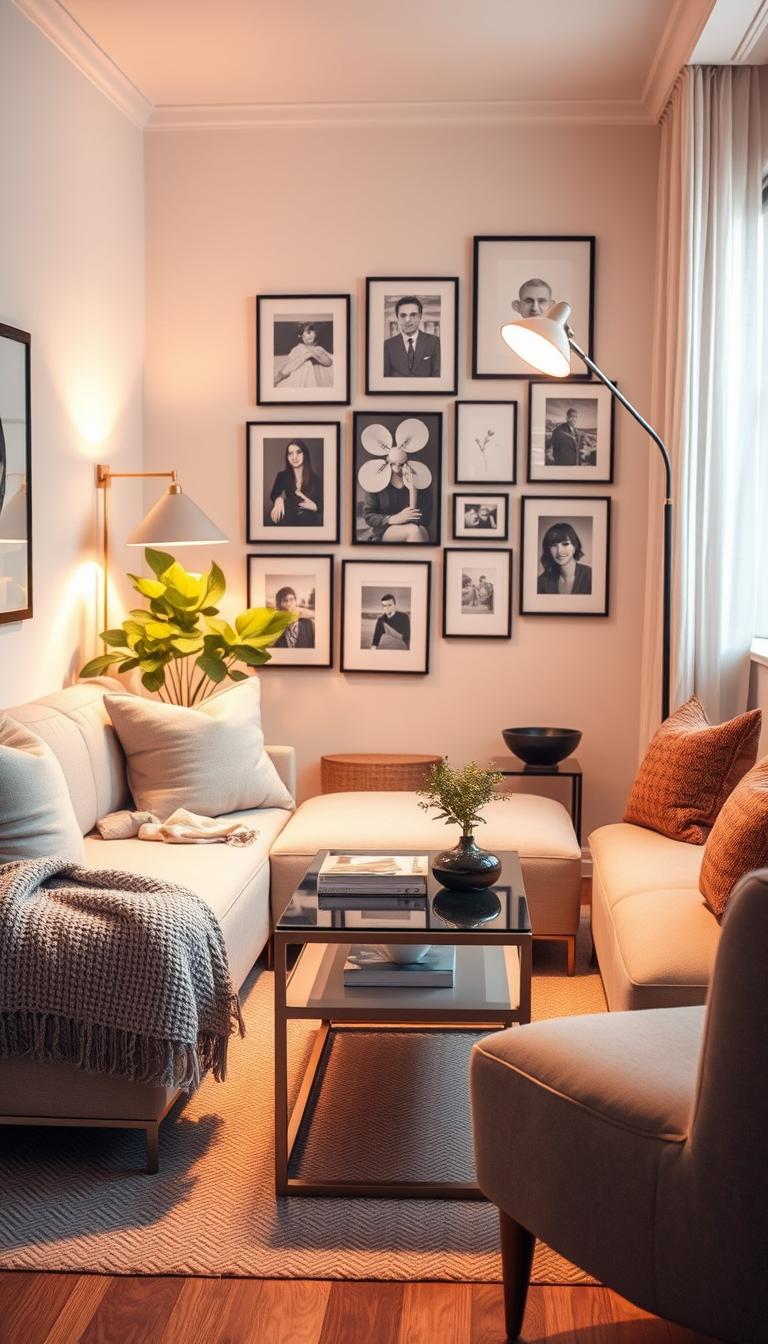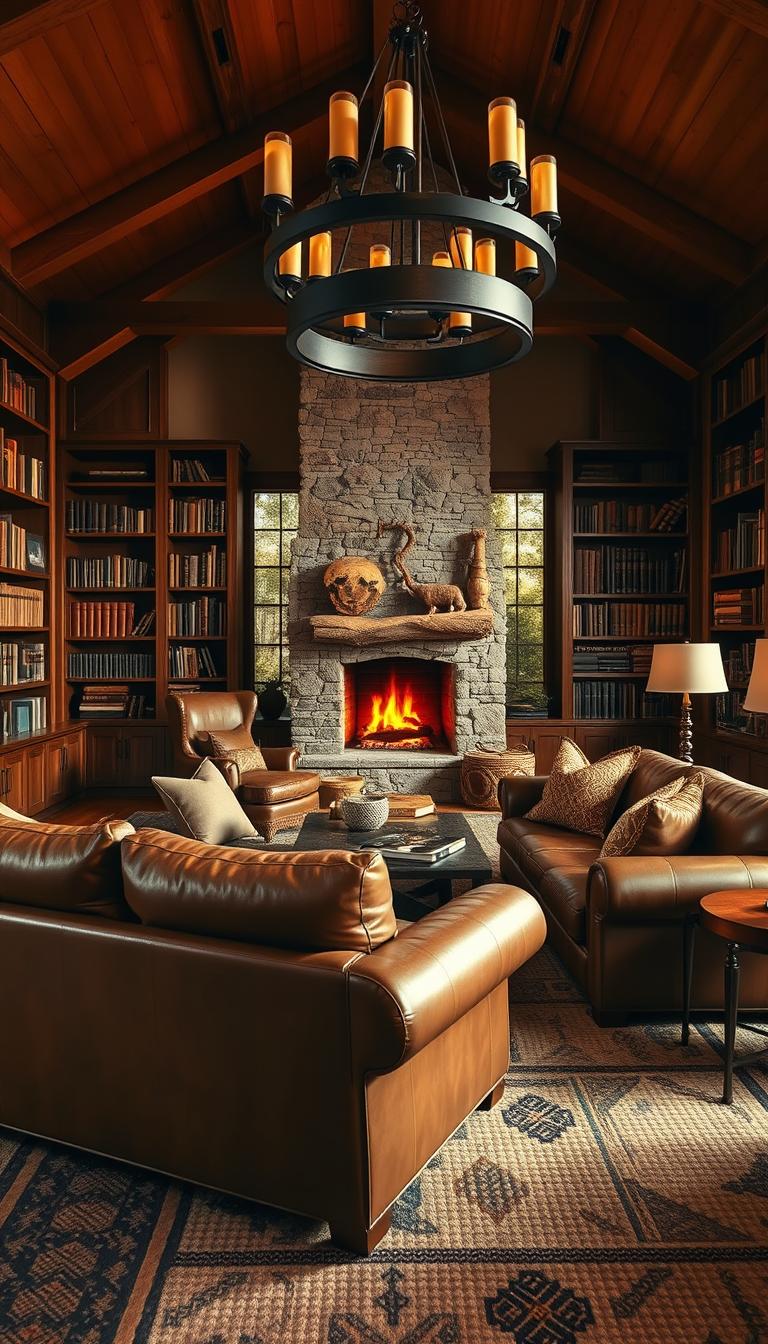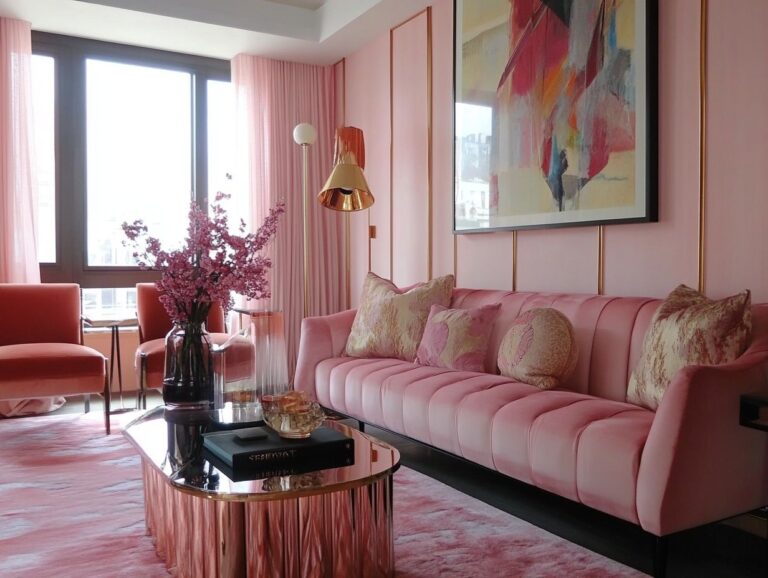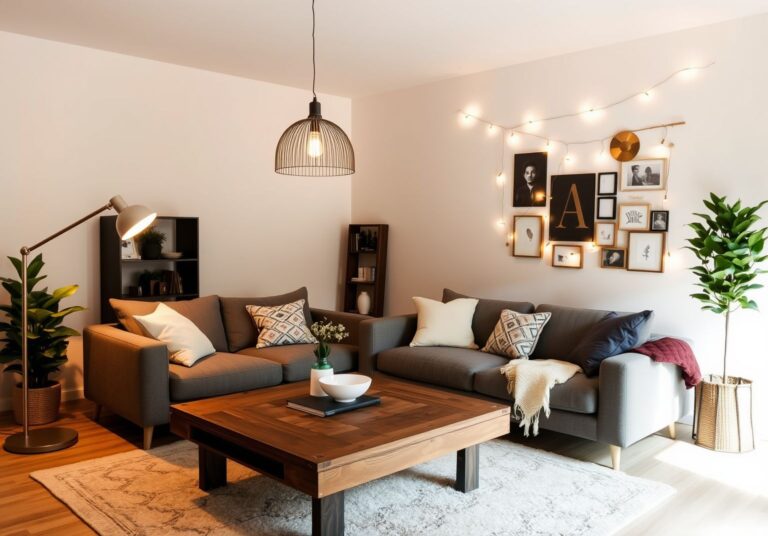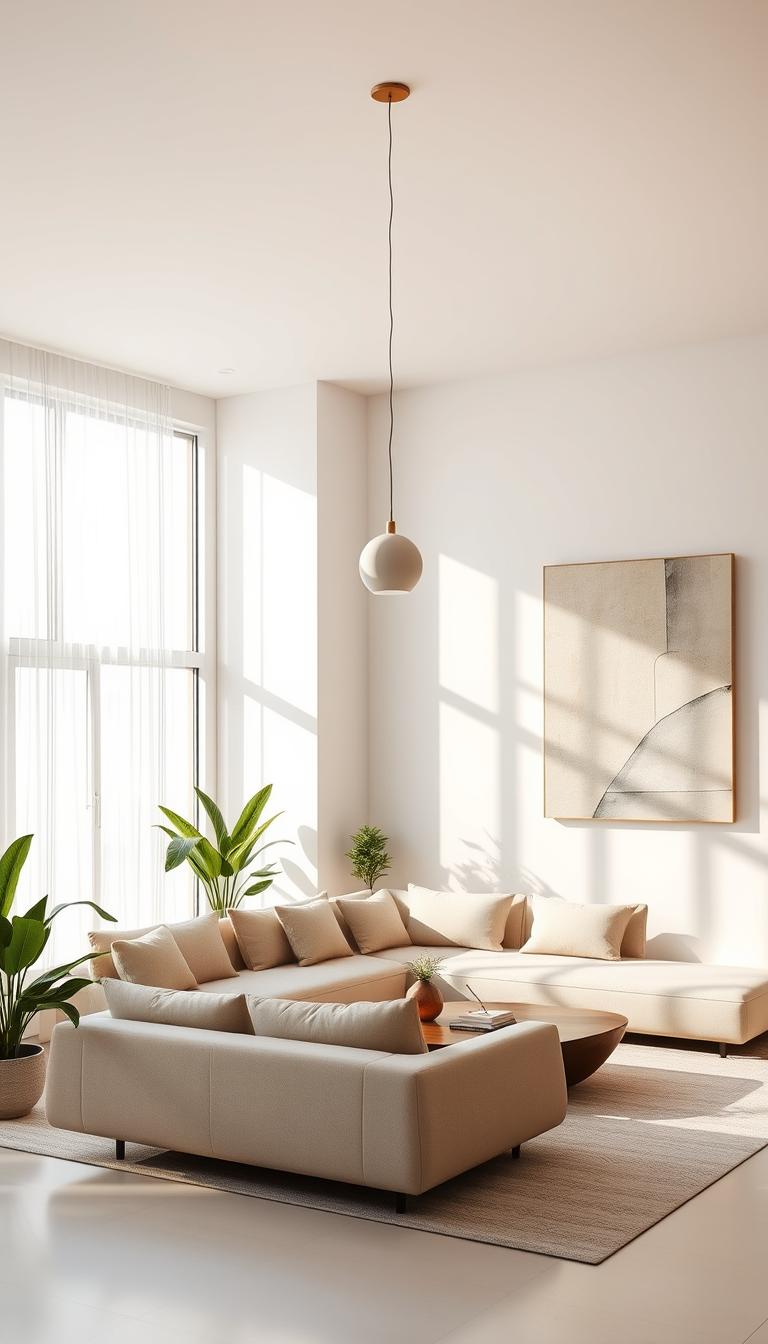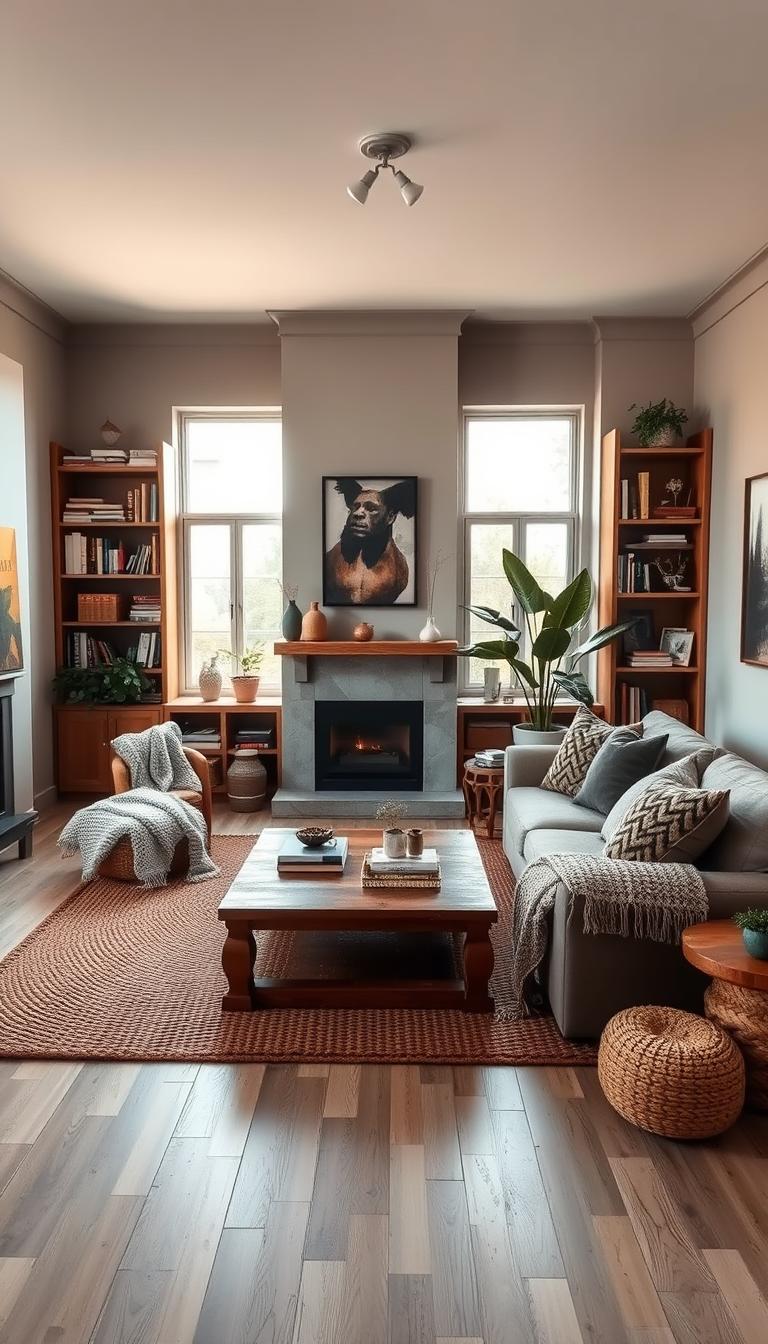Cozy Living Room Design: Essential Tips & Ideas
Ever walked into a home that instantly made you feel at ease? Imagine having that same soothing energy in your own space. After a long day, there’s nothing better than sinking into a soft chair, surrounded by gentle lighting and textures that whisper, “You’re home.”
Creating a welcoming atmosphere isn’t just about aesthetics—it’s about crafting a sanctuary. Studies show that environments with layered lighting and plush fabrics reduce stress by 34%. Designers like Lindley Arthur emphasize balancing functionality with warmth, while Prudence Bailey champions natural materials like wood and stone to ground a room.
This guide shares practical steps to blend comfort and style. Discover how velvet cushions, ambient lamps, and earthy color palettes work together. Learn why experts prioritize rugs for depth and built-ins for clutter-free harmony.
Whether you’re refreshing a corner or starting fresh, these ideas adapt to any layout. Let’s turn your vision into a space that feels like a warm hug at first glance.
Table of Contents
Understanding the Essence of a Cozy Living Room
What transforms four walls into a haven you never want to leave? It’s the marriage of simplicity and warmth—elements that turn ordinary areas into retreats. Spaces radiating comfort prioritize tactile experiences over trends, using plush throws and inviting seating to engage your senses.
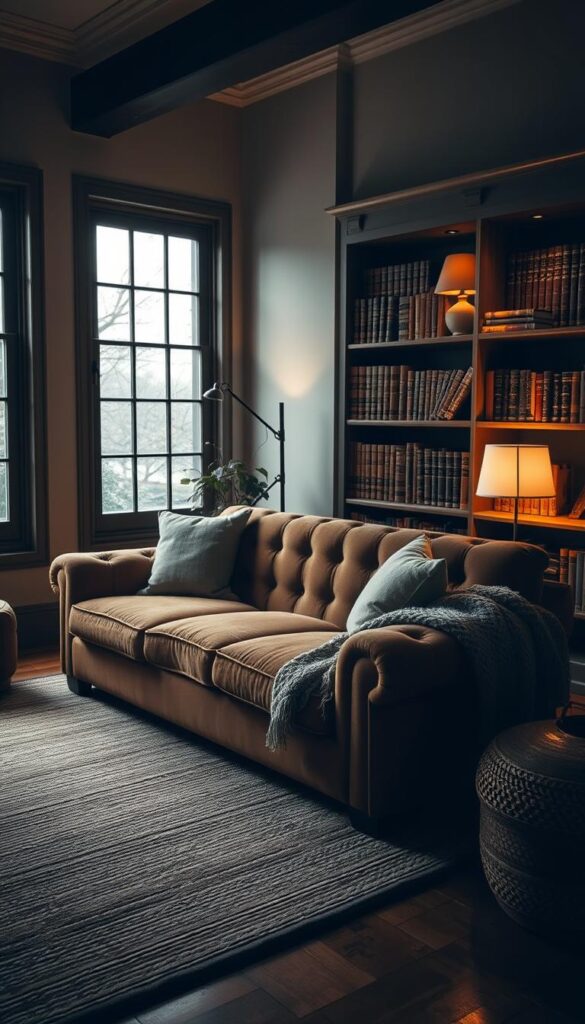
Central to this concept is functional harmony. A sturdy coffee table anchors seating areas while offering storage for blankets or books. Soft fabrics like velvet or wool add depth, while curved furniture shapes encourage relaxation. Farmhouse styles achieve this with rustic wood accents, while Scandinavian designs lean on clean lines and muted tones.
Three principles define this approach:
- Prioritizing quality over quantity in decor choices
- Using textures to create visual interest without clutter
- Balancing open areas with intimate seating clusters
Whether through a minimalist shelf displaying cherished mementos or layered rugs underfoot, every detail contributes to the room’s welcoming spirit. The goal? Craft an environment that feels both lived-in and intentional—where every element serves comfort.
Key Elements of “Cozy living room design”
What makes a space feel like a retreat after a hectic day? Three foundational ingredients work together: tactile layers, thoughtful lighting, and intentional accents. These components transform blank canvases into sanctuaries that engage both eyes and fingertips.
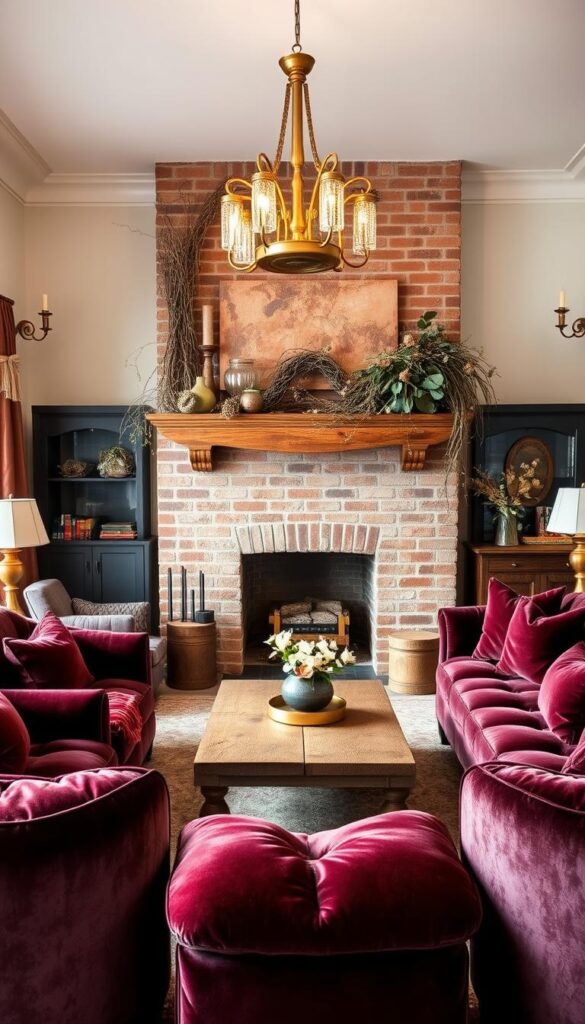
Texture combinations make surfaces visually appealing and physically inviting. Try pairing nubby wool throws with smooth leather ottomans or silk curtains against rough-hewn wood. This contrast creates depth while maintaining a unified room feel.
| Texture Type | Effect on Room Feel | Material Examples |
|---|---|---|
| Plush | Softens hard surfaces | Velvet, faux fur |
| Natural | Adds organic warmth | Jute, linen |
| Metallic | Introduces subtle shine | Brass accents |
Decorative elements like throw pillows serve dual purposes. They inject color while supporting posture during movie nights. Choose covers in varying sizes—20×20″ and 18×18″ work well together. Rotate seasonal patterns to keep the look fresh without redesigning everything.
For balanced room ideas, follow the 60-30-10 rule: 60% dominant texture (like a rug), 30% secondary material (upholstery), and 10% metallic or glossy finishes. This formula prevents sensory overload while letting personal style shine through.
Remember: coziness thrives in edited spaces. Limit throw pillows to five per sofa and anchor seating areas with one bold-textured item—a chunky knit pouf or rattan chair works beautifully.
Incorporating Warm Color Palettes and Textures
Color holds remarkable power to shape how a space feels. Warm neutrals like terracotta and soft browns act as visual anchors, wrapping walls and furniture in earthy familiarity. These tones mimic natural elements—think sunbaked clay or autumn leaves—to create instant comfort.
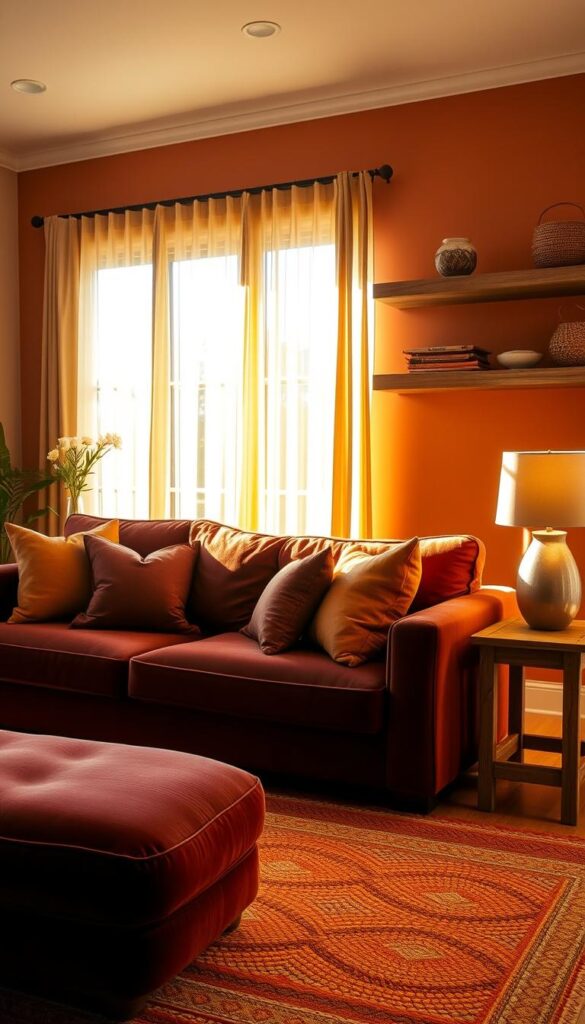
Strategic hue selection determines a room’s mood. Muted yellows add subtle cheer without overwhelming, while burnt orange accents energize neutral backdrops. For balance, pair deep rust tones with creamy whites—this combo prevents darkness from dominating smaller spaces.
Three texture-blending techniques elevate warmth:
- Layer chunky knit throws over smooth leather chairs
- Place nubby jute rugs beneath velvet-upholstered sofas
- Mix matte ceramic vases with brass candle holders
Successful rooms often follow a 70-20-10 ratio: 70% base textures (walls/floors), 20% secondary materials (furniture), and 10% metallic or glossy finishes. This framework maintains harmony while allowing personal flair through patterned pillows or woven baskets.
Lighting amplifies these choices. Warm LED bulbs cast golden glows across textured surfaces, making every thread and grain feel intentional. Together, these elements turn blank canvases into inviting retreats that welcome both solitude and connection.
Using Layered Lighting to Enhance Ambiance
Light shapes how we experience spaces—like a silent conductor orchestrating mood. Layered lighting combines three types to craft adaptable environments: ambient for overall glow, task for focused needs, and accent for artistic flair. This approach lets you highlight textures while keeping the area functional day or night.

Ambient lighting forms the foundation. Think ceiling fixtures or recessed lights that wash walls with soft radiance. Pair these with task lighting like adjustable table lamps near reading chairs. A brass swing-arm sconce above a side table? Perfect for evening crossword puzzles.
Accent pieces add drama. Try wall-mounted fixtures flanking artwork or LED strips under shelves. These create depth while making cherished objects feel special. For flexibility, install dimmers on main lights—lower brightness for movie nights, boost it during board games.
| Light Type | Purpose | Examples |
|---|---|---|
| Ambient | General illumination | Chandeliers, track lighting |
| Task | Activity-focused | Desk lamps, pendant lights |
| Accent | Visual interest | Wall sconces, picture lights |
Smart bulbs like Philips Hue let you tweak color temperatures. Warm whites (2700K) mimic sunset glows, while cool tones energize mornings. By balancing these layers, you craft spaces that feel inviting yet practical—a harmony of light and life.
Furniture Selection and Layout for Maximum Comfort
Furniture forms the backbone of comfort in any gathering space. The right pieces invite relaxation while supporting daily activities. Ergonomic support and material quality matter most—opt for deep-seated sofas with feather-down cushions or performance fabrics that withstand wear.
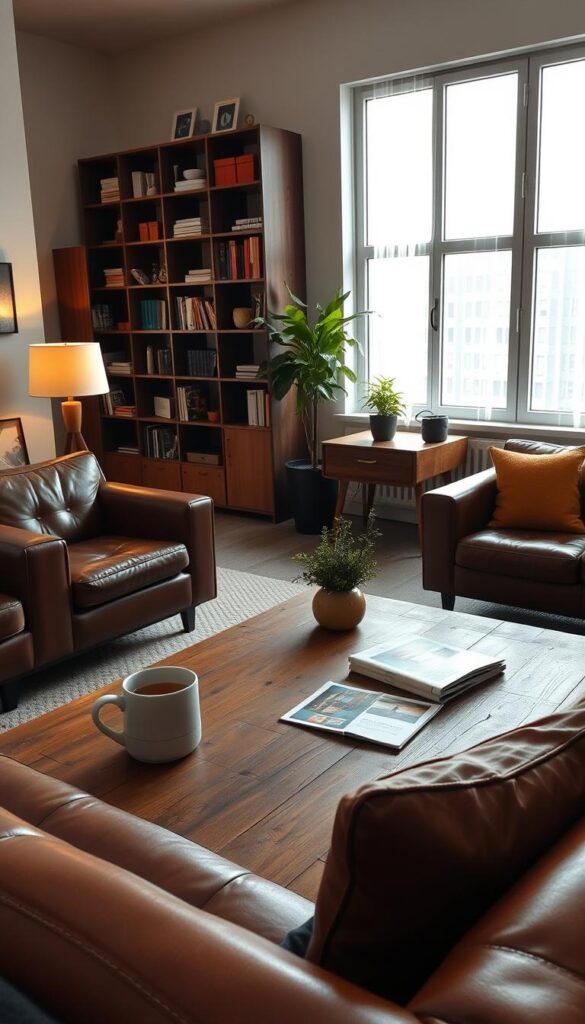
Smart layouts begin with traffic flow. Leave 30-36 inches between seating groups for easy movement. Angle two armchairs toward a sofa to create conversation nooks. Multipurpose ottomans work double duty as footrests and hidden storage—perfect for board games or extra blankets.
Your coffee table deserves strategic attention. Choose oval shapes in small areas to prevent shin bumps. Models with shelves or drawers keep remotes and magazines tidy. For modern design ideas, try a sleek metal-and-glass piece. Eclectic spaces shine with reclaimed wood topped by art books and a ceramic tray.
| Furniture Type | Comfort Feature | Style Match |
|---|---|---|
| Sectional Sofas | Modular flexibility | Contemporary |
| Swivel Chairs | 360° conversation | Midcentury |
| Nesting Tables | Space-saving | Bohemian |
Balance comes from mixing proportions. Pair a substantial leather couch with airy acrylic side tables. Remember: every item should earn its place through beauty and utility. That velvet bench by the window? It’s both a sunny reading spot and extra seating when friends visit.
Creating a Minimalist Yet Inviting Space
How can less become more in your home environment? Minimalist design strips spaces down to their essentials, focusing on clean-lined furniture and intentional choices. Warm neutrals and tactile materials prevent starkness, creating calm without sacrificing character.
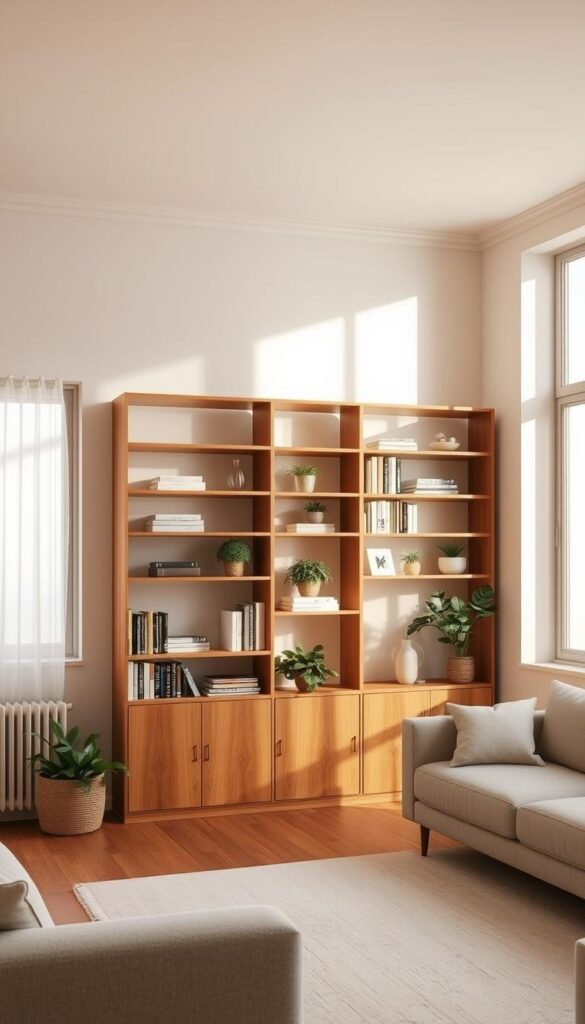
Decluttering with Purpose
Start by removing items that don’t serve joy or function. Built-in shelves display curated books, while storage ottomans hide throws. This edited approach transforms cluttered areas into serene zones.
Hidden solutions maintain order. Try floating benches with lift-up seats or handleless cabinets. These keep daily essentials accessible yet invisible, preserving the clean aesthetic.
Balance sleek lines with warmth. A neutral palette of linen and oak gains depth from a wool rug. Add life with a single potted fern—its organic shape softens angular furniture.
Well-organized areas thrive on restraint. Leave surfaces mostly clear, using a ceramic vase or stack of art books as focal points. The result? A harmonious space that feels both refined and relaxed.
Infusing Natural Elements and Greenery into Your Living Room
Bringing the outdoors in isn’t just a trend—it’s a design philosophy that breathes life into your home. Studies reveal rooms with plants boost mood by 15% while filtering airborne toxins. Start by introducing low-maintenance varieties like snake plants or trailing pothos. These thrive in indirect light and add vertical interest when placed on walls or shelves.

Vintage finds add soul to organic schemes. Hunt for aged terracotta pots or repurposed wooden crates as planters. Pair these with earthy textures like jute rugs or woven hemp baskets. This mix creates depth while honoring sustainability—key in modern and traditional spaces alike.
Three ways greenery elevates your environment:
- Improves air quality by absorbing pollutants
- Softens architectural lines with organic shapes
- Introduces calming biophilic patterns through leaf textures
Balance is crucial. Hang ferns near ceilings to draw eyes upward, then ground the space with a chunky wood coffee table. For cohesive style, repeat materials: match bamboo blinds with rattan trays or stone coasters. The result? A fresh, timeless atmosphere that feels both curated and effortlessly alive.
Designing a Welcoming Coffee Table Arrangement
Your coffee table does more than hold mugs—it’s the heart of your seating area. As a central hub for decor and function, its setup can elevate your entire space. Start by balancing practicality with style: choose trays for corralling remotes or displaying art books alongside fresh blooms.

Color coordination ties everything together. Pull hues from nearby pillows or rugs into your arrangement. A navy throw? Add matching ceramic coasters. Earthy tones? Try terracotta vases with dried grasses. This creates visual harmony without matching everything perfectly.
Keep surfaces inviting but clutter-free. Use the rule of threes: group a stack of hardcover books, a sculptural bowl, and a petite plant. Rotate seasonal items—swap pinecones for seashells in summer—to keep the look fresh. Woven baskets underneath offer hidden storage for blankets or board games.
Your chairs and sofa should complement the table’s proportions. Low-profile seating pairs well with sleek, modern tables, while plush armchairs suit chunkier wood designs. Leave 18 inches between seats and table edges for easy reach. This ensures comfort while maintaining a polished aesthetic.
Mixing Modern and Eclectic Decor Styles
Why settle for one aesthetic when multiple can harmonize? Blending sleek modern lines with free-spirited bohemian accents creates spaces that feel both curated and spontaneous. This approach lets you showcase personality while maintaining functional elegance.
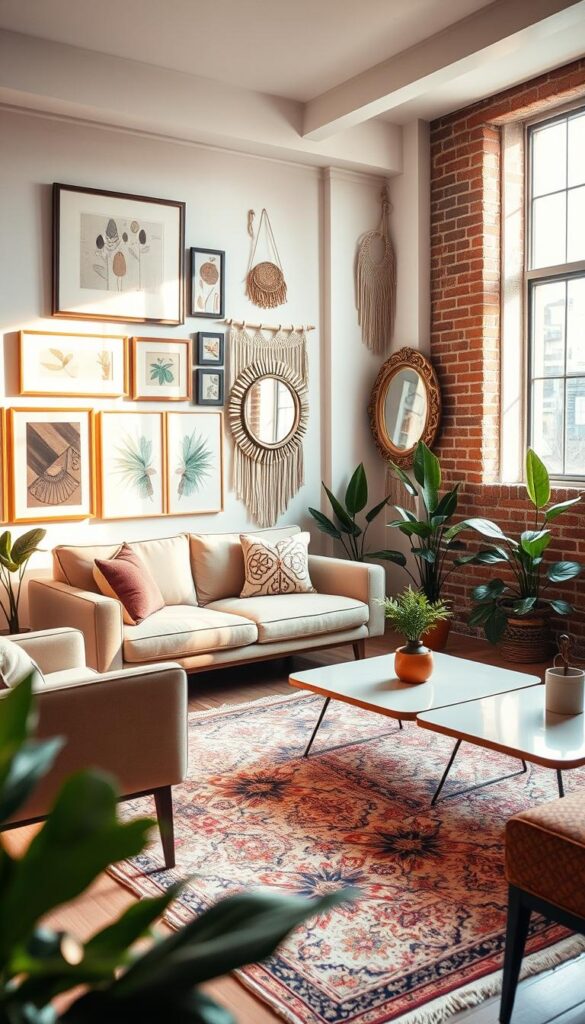
Embracing Midcentury Modern Influences
Midcentury design brings timeless structure to eclectic mixes. Think tapered legs on sofas paired with geometric lamps—these elements anchor wilder patterns or textures. A designer might balance a walnut credenza with a vibrant abstract painting above it, proving simplicity and boldness can coexist.
Bohemian touches soften rigid lines. Try macramé wall hangings near a streamlined shelving unit or kilim pillows on a leather couch. These contrasts add warmth without cluttering the visual flow.
| Style | Key Feature | Material Pairing |
|---|---|---|
| Midcentury | Clean angles | Walnut + brass |
| Boho | Organic patterns | Woven cotton + clay |
| Modern | Minimal decor | Concrete + velvet |
Statement rugs unite diverse pieces. A Persian-style carpet with muted tones ties together a metallic coffee table and linen chairs. Layer smaller pillows in varying textures—faux fur next to linen—to deepen the tactile experience.
Successful eclectic spaces thrive on intentional contrasts. Pair a sculptural floor lamp with a rustic jute basket, or place glossy ceramic vases beside matte-finished side tables. These combinations feel collected over time, telling your unique story through designer-level cohesion.
Highlighting Focal Points with Art and Gallery Walls
Gallery walls do more than decorate—they tell stories that wrap a space in warmth. A well-curated collection becomes the heart of your area, reflecting personal tastes while amplifying comfort through visual harmony.
Choose pieces that echo your color scheme and textures. Earthy landscapes or abstract works with warm tones blend seamlessly with throw blankets and wooden furnishings. Oversized canvases above sofas create instant drama, while smaller frames on shelves add subtle charm.
| Arrangement Style | Visual Impact | Best For |
|---|---|---|
| Grid Layout | Structured elegance | Modern spaces |
| Organic Cluster | Eclectic energy | Bohemian themes |
| Salon-Style Stack | Vertical interest | Narrow walls |
Balance is key. Leave breathing room between frames and furnishings like side tables or lamps. Try painter’s tape mockups before hammering nails—this ensures proportional spacing.
Mix mediums for depth: pair framed prints with woven baskets or metallic sculptures. Add throw pillows that pick up colors from artwork to tie elements together. Dark walls make gold-framed pieces pop, while white backgrounds let vibrant art shine.
Lighting elevates displays. Picture lights cast warm glows on favorite pieces, while nearby floor lamps highlight coziness-boosting textures. Remember—your gallery should feel collected, not cluttered, inviting eyes to linger and hearts to feel at ease.
Creative Use of Vintage and Second-Hand Furniture
Ever stumbled upon a chair that whispers stories from decades past? Vintage pieces bring soul to modern spaces through their imperfections and history. Designers like Sarah Vaile prove that mixing eras creates depth—imagine a 1970s rattan chair beside a sleek concrete coffee table.
Sourcing Sustainable Finds
Hunting for second-hand treasures offers both environmental perks and unique style opportunities. Online marketplaces and estate sales are prime places to discover solid wood dressers or midcentury lamps. These materials often outlast modern alternatives, reducing waste while adding character.
Try these strategies for blending old and new:
- Pair curved vintage seating with geometric modern shelving
- Use antique books as risers for potted plants on side tables
- Repurpose old suitcases into quirky storage solutions
Elaine Santos demonstrates how burl wood accents can anchor contemporary spaces. Place a refurbished cabinet beneath abstract art to create focal points. Vintage textiles like embroidered pillows add texture without overwhelming minimalist schemes.
Quality materials from past decades—think brass hardware or hand-carved details—elevate basic layouts. Stack weathered books on a chrome shelf for balanced contrast. This approach celebrates sustainability while crafting spaces that feel curated rather than catalog-perfect.
Optimizing Small Living Room Spaces for Coziness
How do you turn tight quarters into a welcoming retreat? Smart planning transforms limited square footage into areas that feel both spacious and intimate. Designers recommend starting with multipurpose furniture—like storage ottomans or nesting tables—to save space while adding character.
Clever Arrangements for Flow
Arrange seating to define zones without walls. Place a loveseat perpendicular to a slim console table, creating separate areas for lounging and dining. Leave 24 inches between pieces for easy movement—this makes the area functional yet uncluttered.
| Layout Strategy | Space Benefit | Example |
|---|---|---|
| Floating Furniture | Opens floor area | Wall-mounted desk |
| Vertical Storage | Maximizes height | Floor-to-ceiling shelves |
| Curved Shapes | Softens corners | Round accent chairs |
Built-ins work wonders in compact areas. Custom bookshelves flanking a window seat provide display space and hidden compartments. Choose light-toned woods to keep the atmosphere airy—this trick makes the room feel larger without cold minimalism.
Blend style and practicality through layered textures. A wool rug anchors seating groups, while velvet cushions add softness. Rotate decor seasonally: woven baskets in summer, knit throws in winter. This approach keeps the space fresh over time without major changes.
Incorporating Rich Textures: Rugs, Pillows, and Throws
Texture is the silent storyteller in your home. It turns flat surfaces into inviting landscapes that make living spaces feel layered and lived-in. A chunky knit throw draped over a sofa or a nubby jute rug underfoot adds tactile warmth that eyes and hands appreciate.
Start with your largest textile—the rug. Choose low-pile wool for high-traffic zones or plush shag for barefoot comfort. Layer smaller accent rugs in contrasting materials, like a hide over sisal, to define seating areas. This grounds the living space while adding visual depth.
Pillows are your texture toolkit. Mix 22-inch linen squares with 18-inch velvet lumbars or round faux-fur cushions. Stick to three colors max—terracotta, cream, and charcoal work well—to keep patterns from clashing. Rotate covers seasonally: lightweight cotton for summer, cable-knit for winter.
| Material | Best Pairing | Room Impact |
|---|---|---|
| Velvet | Leather chairs | Adds luxe contrast |
| Linen | Wooden benches | Enhances airy vibe |
| Faux Fur | Metal frames | Softens hard edges |
Throws make living areas instantly feel cozy. Drape a waffle-weave cotton blanket over armrests or fold a mohair piece at the foot of a bench. For balance, pair heavy fabrics with sleek surfaces—think a cable-knit throw on a polished concrete coffee table.
Remember: odd numbers create harmony. Use five pillows max on a sofa, mixing two textures. In smaller living spaces, opt for lightweight throws that add warmth without bulk. These choices transform your area into a sanctuary that feel cozy yet curated.
Balancing Function and Aesthetics with Multifunctional Pieces
Have you ever wished your furniture could do more than just look good? Smart spaces thrive when pieces pull double duty—serving practical needs while enhancing visual appeal. A storage ottoman becomes both a footrest and linen holder, while a bookshelf transforms into room-dividing art.
Form Meets Purpose
Strategic selections create natural focal points that command attention. A console table with built-in drawers organizes mail while displaying sculptural vases. These pieces work harder without shouting for attention.
Your color palette acts as glue for diverse elements. Neutral tones like warm grays let bold textures shine, while muted greens connect indoor plants to upholstery. Repeat hues across materials—wooden legs matching ceramic lamps—to unify the look.
| Piece | Function | Style Benefit |
|---|---|---|
| Sleeper Sofa | Guest bed + seating | Clean lines suit modern spaces |
| Nesting Tables | Space-saving surfaces | Geometric shapes add interest |
| Wall Unit | Storage + display | Open shelves create depth |
Midcentury modern designs excel at blending utility with beauty. A walnut credenza stores board games behind sliding doors while showcasing abstract art above. Look for tapered legs and organic curves—these details elevate basic storage.
Adaptable choices future-proof your space. Modular shelving grows with collections, and convertible desks adjust from work mode to dining. Choose sustainable materials like bamboo or recycled metal for pieces that age gracefully.
Personalizing Your Space with Unique Accents
Personal touches transform rooms into reflections of your journey. Whether it’s a framed concert ticket or a hand-painted vase, these details make feel environments authentically yours. Studies show spaces with meaningful items boost emotional connection by 40%.
Showcasing Personal Mementos
Curate a gallery wall that mixes family photos with abstract art. Use varied frame styles—try brass for glamour or walnut for warmth. Place larger pieces at eye level, smaller ones higher to guide the gaze naturally.
Balance keeps displays intentional. Group three related items on shelves: a vintage clock, stacked books, and a potted succulent. Rotate seasonal pieces like holiday cards or travel souvenirs to refresh the room design without overhaul.
| Display Style | Key Elements | Visual Impact |
|---|---|---|
| Eclectic Mix | Photos + textiles + ceramics | Dynamic energy |
| Monochromatic | Black-and-white prints | Cohesive elegance |
| Floating Shelves | Plants + mini sculptures | Airy organization |
Blend heirlooms with modern room design by pairing Grandma’s quilt with sleek throw pillows. Handmade items like macramé wall hangings add texture while telling your story. Built-in shelves from Section 09 offer clutter-free zones for rotating treasures.
Authenticity shines through unexpected pairings. Hang a modern mirror above a rustic bench, or place childhood drawings in luxe frames. These choices make feel spaces uniquely inviting—a true extension of who you are.
Conclusion
Crafting a welcoming space blends practicality with personality—it’s where daily life unfolds comfortably. Throughout this guide, we’ve explored how textures, lighting, and smart layouts transform ordinary areas into inviting retreats. From plush rugs to adjustable lamps, each choice contributes to an environment that feels both functional and heartfelt.
Mixing materials creates depth without clutter. Try combining woven baskets with metallic accents or velvet cushions against leather chairs. Remember: layered lighting adapts to moods, while multipurpose furniture like storage ottomans keeps essentials within reach yet out of sight.
Your home should mirror your journey. Display travel souvenirs beside modern art or layer heirloom quilts over contemporary sofas. These personal touches turn generic layouts into stories worth sharing.
Ready to begin? Start with one change—swap harsh bulbs for warm LEDs or introduce a statement plant. Revisit key strategies like the 60-30-10 texture rule or vertical storage solutions. Every edit brings you closer to a space that balances beauty with lived-in ease.
Now’s the time to experiment. Your ideal sanctuary awaits—one thoughtful choice at a time.

